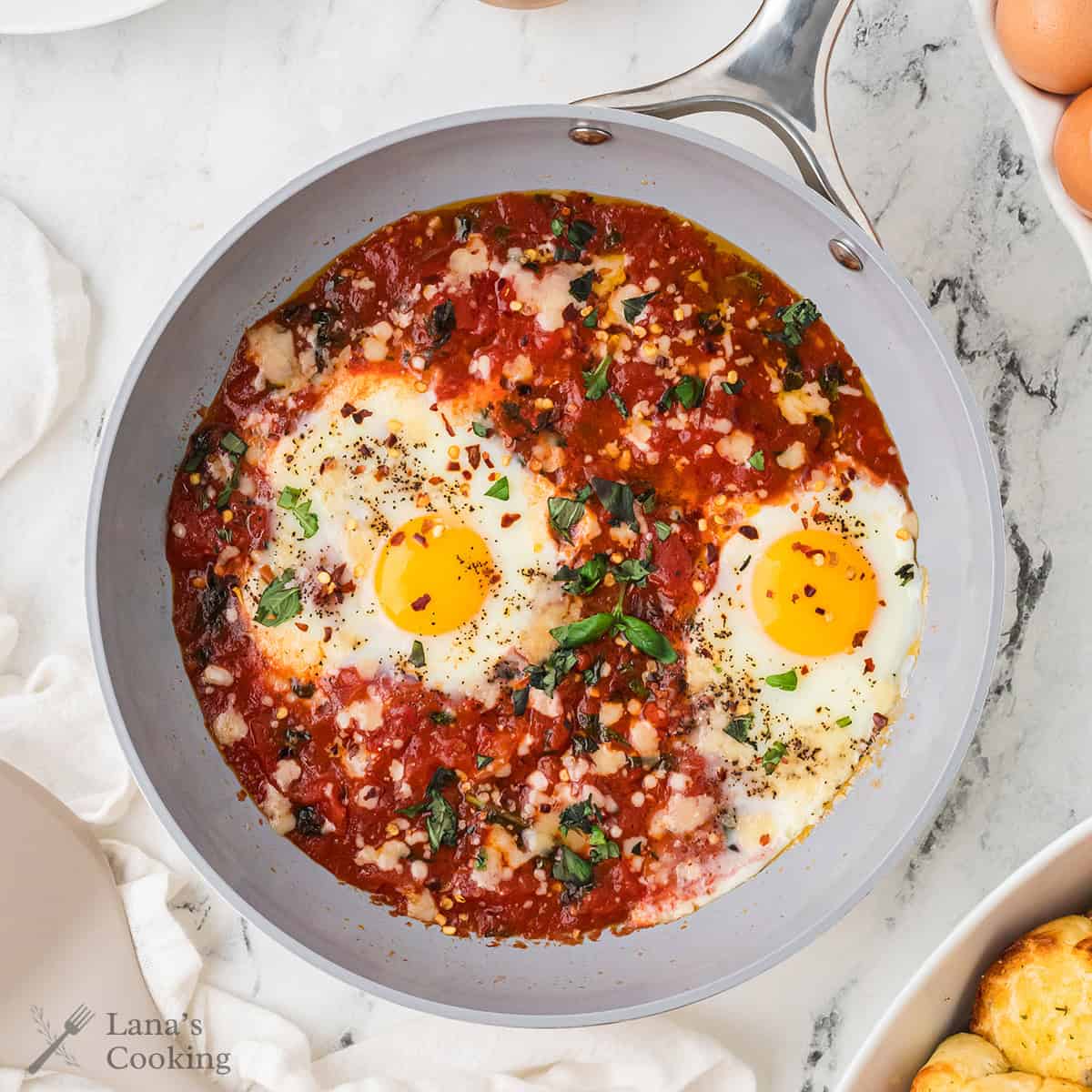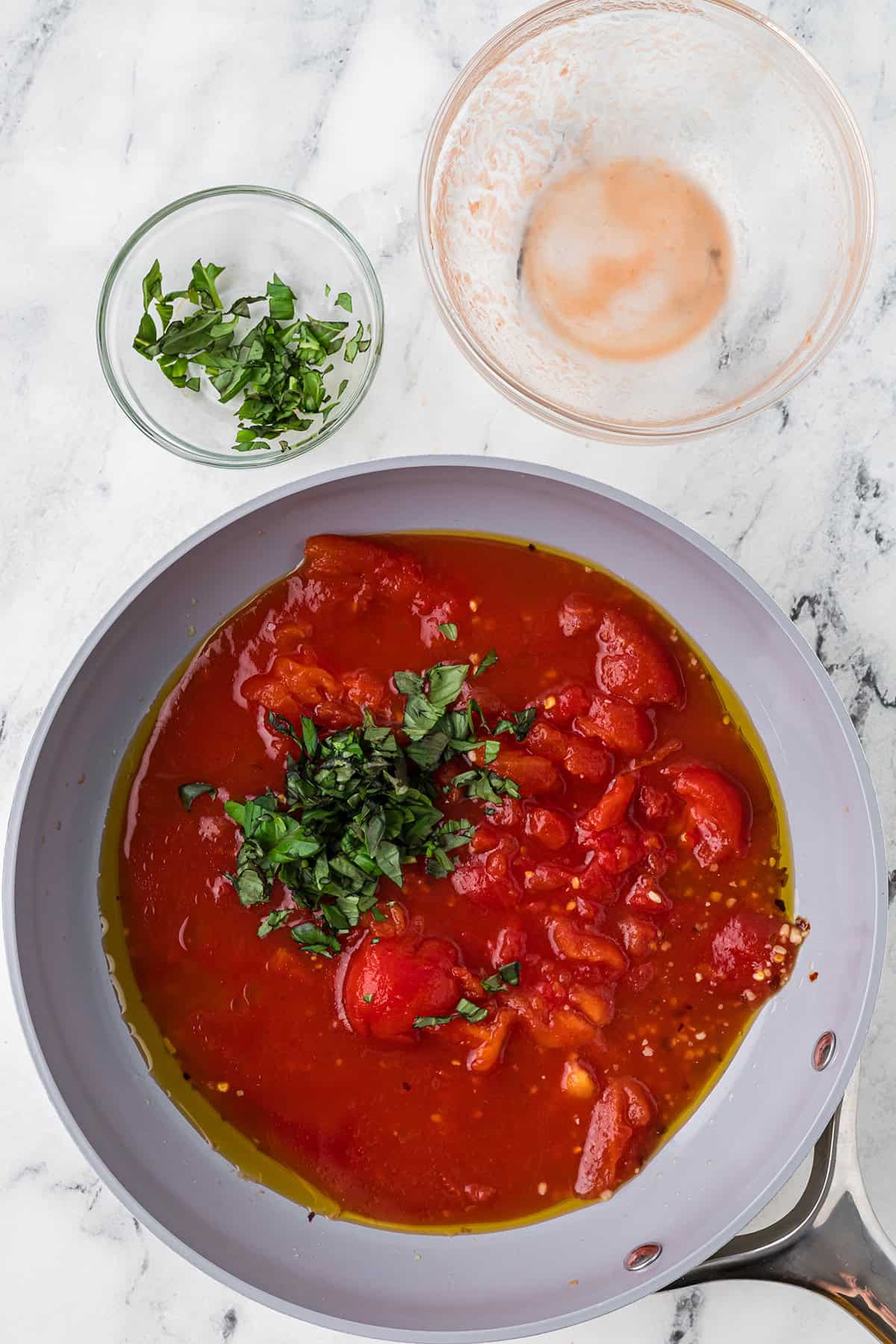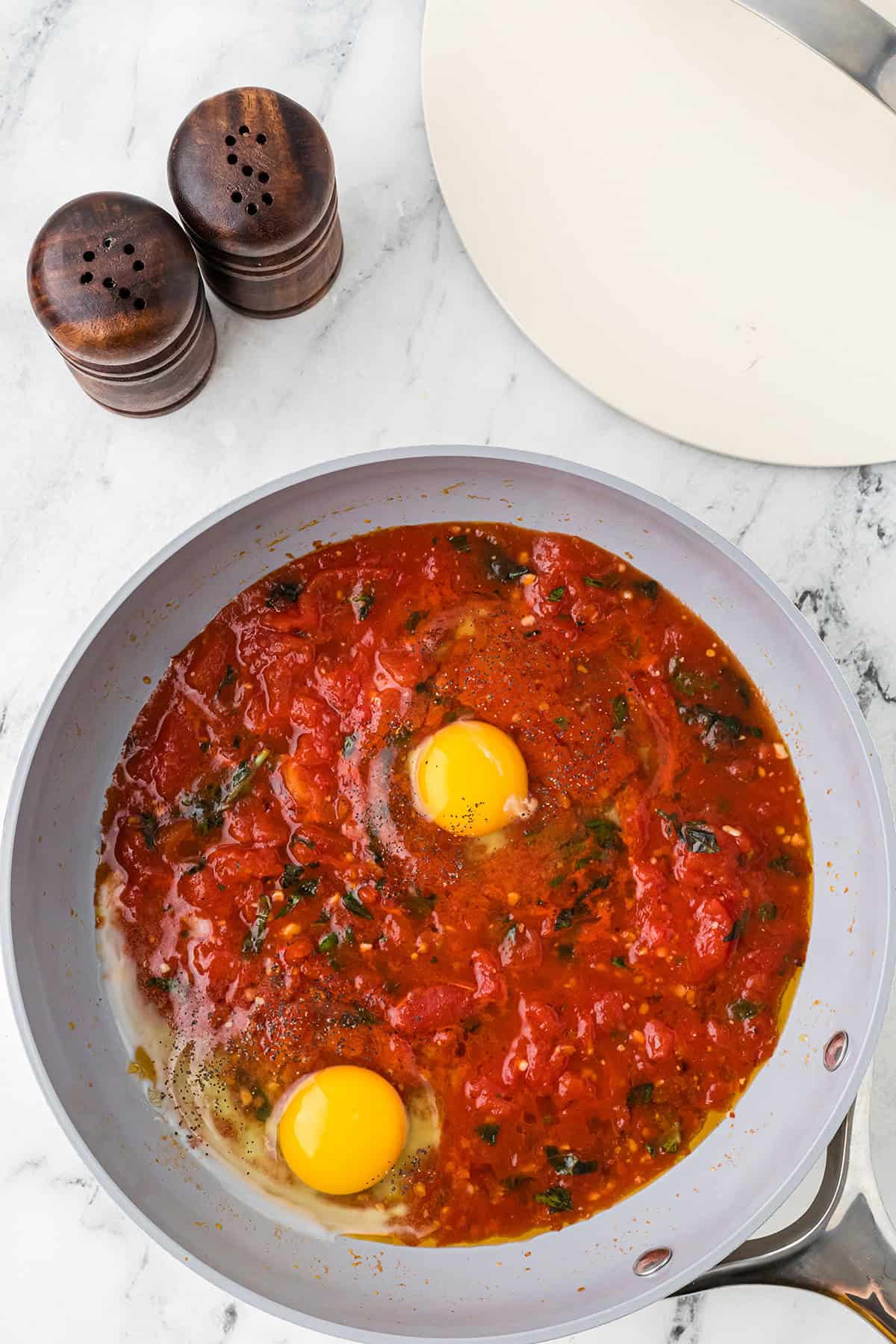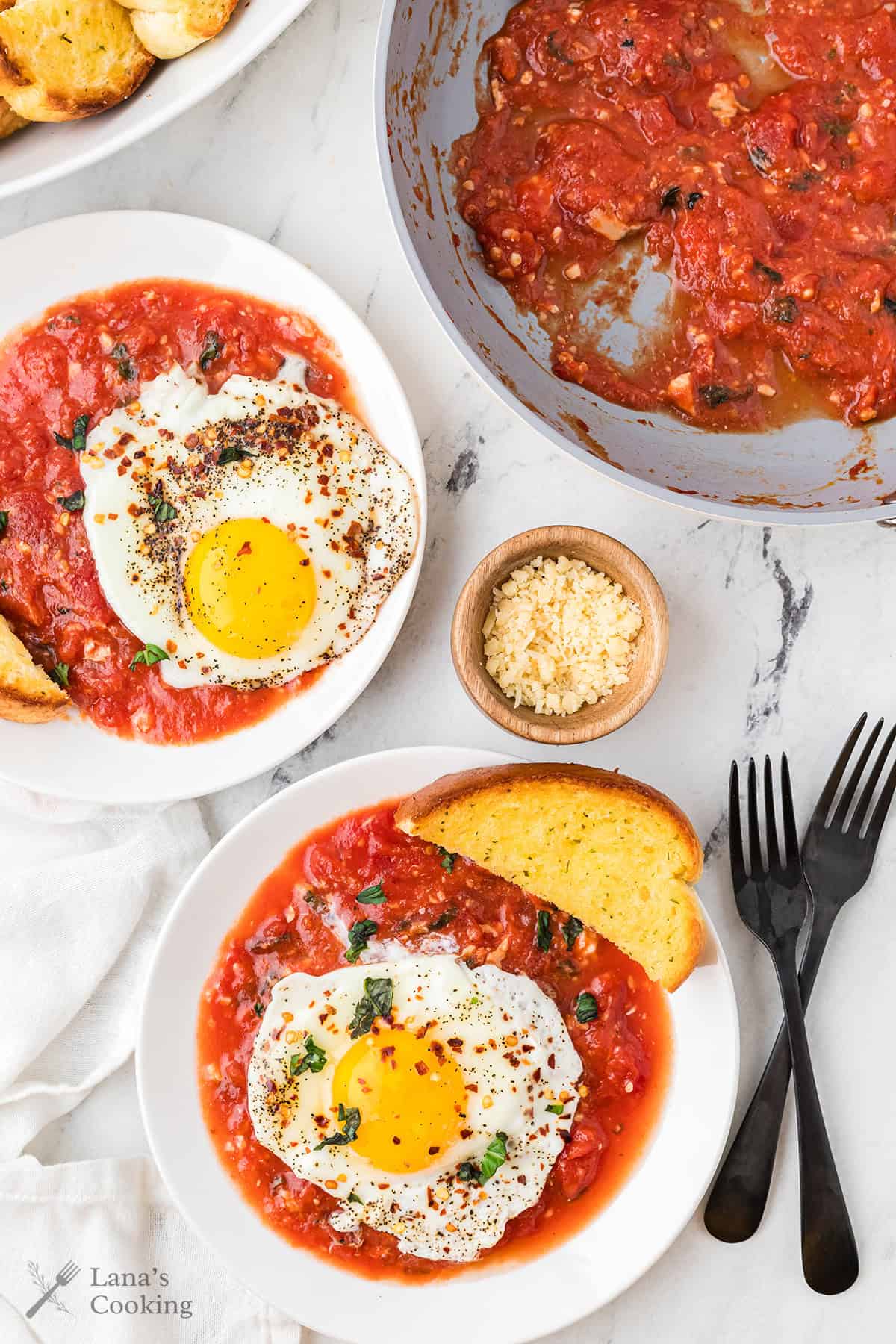When you want something warm and just a bit spicy, this simple skillet of Eggs in Purgatory is the perfect choice. It’s made with simple ingredients like canned tomatoes, garlic, and eggs, yet it feels special every single time. It’s quick enough for a weeknight supper and satisfying enough for a slow weekend brunch or even a plate of late night eggs after an evening on the town. Be sure to have some good bread on hand because you won’t want to leave a drop of that sauce behind.
One quiet evening, I found myself alone at dinnertime. BeeBop was away on business, and after a long day, I wasn’t about to fuss with anything complicated. I wanted something good and filling that wouldn’t leave me with a pile of dishes.

Eggs in Purgatory had been on my radar for a while. I’d read about it, seen it in cookbooks, even watched chefs prepare it on TV. But for whatever reason, I’d never made it myself. That night seemed like the perfect chance.
From the time I took the skillet out of the cabinet until I sat down to enjoy my dinner was no more than 20 minutes. I’d call that quick and easy!
I did a little research on the history of Eggs in Purgatory, and like so many classic recipes, the actual origin of it is unknown. It’s believed to come from Southern Italy, where it’s called uova in purgatorio. Some say the eggs represent “souls” and the spicy tomato sauce is the purgatory they simmer in.
Whether you believe the symbolism or not, the flavor is downright heavenly. You’ll find similar ideas in Middle Eastern shakshuka or Mexican huevos rancheros, but this one has a personality all its own.
I hope you’ll give this a try and let me know how you like it. Remember, you can adjust the red pepper flakes according to your own taste. If you like yours really hot, use a lot. If you lean more to the milder side, use a lot less 🙂. Oh, and don’t forget plenty of garlic bread or toast for dunking!
Recipe Snapshot
Cuisine: Mediterranean
Cooking Method: Stovetop
Total Time: 22 Minutes
Servings: 1 (generous serving!)
Primary Ingredient(s): Olive oil, garlic, red pepper flakes, tomatoes, basil, eggs, Parmesan cheese
Skill Level: Easy
What You’ll Like About This Recipe
- Comes together in about 20 minutes with one skillet.
- Made from pantry staples you probably have on hand.
- Easy to adjust the spice level to suit your taste.
WHAT PEOPLE ARE SAYING …
“Tried these eggs this morning. EXCELLENT!!!”
— Sandy P
Ingredient Notes

This post contains affiliate links. Lana’s Cooking is reader-supported and earns a tiny commission at no extra cost to you when you shop from our links.
- Olive Oil — Use extra-virgin olive oil if you have it. It starting building that Mediterranean flavor right from the start.
- Garlic — Just one clove of fresh garlic is all you need for a whole lot of flavor. Be careful not to let it brown which will give it a bitter taste.
- Red Pepper Flakes — Use more or less depending on how spicy you like it. My usual choice is the McCormick brand of red pepper flakes.
- Canned Whole Plum Tomatoes — These break down into a lovely rustic sauce. I usually give them a quick mash with a spoon or potato masher. If you can access San Marzano tomatoes, they’re the best of the best! But plain old Hunt’s works well if you can’t get them.
- Basil — Fresh basil is always, always best, but dried will do in a pinch. Just use less if it’s dried.
- Eggs — Use large, fresh eggs. If you have time to let them sit out and come to room temperature, they’ll poach a bit more evenly, but it’s not crucial.
- Parmesan Cheese — Grated fresh Parmesan adds that little touch of richness. You don’t want to skip it.
The complete ingredient list with detailed measurements is included in the printable recipe card at the bottom of this post.
How to Make Eggs in Purgatory




- Start by warming the olive oil in a small skillet over medium heat.
- Add the garlic and red pepper flakes and let them cook for about 2 to 3 minutes. Keep an eye on it because you want the garlic soft and fragrant, not browned.
- Pour in the canned tomatoes, juice and all, and use a spoon or potato masher to break them up right in the pan.
- Stir in most of the chopped basil, saving just a little for garnish later. Let the sauce simmer gently for 8 to 10 minutes until it thickens up a bit.




- Crack each egg into a small bowl first, then gently slide them into the sauce. Make sure the sauce is at a low simmer, not a full boil, so the eggs can poach properly.
- Sprinkle the eggs with a little salt and pepper.
- Add the Parmesan, focusing on the whites and the sauce. Try to keep it off the yolks so they stay golden and pretty.
- Cover the pan and let everything simmer for about 5 minutes, just until the egg whites are set but the yolks are still nice and runny.
- Take the pan off the heat, top with the rest of the basil, and if you like a little extra kick, a pinch more red pepper flakes.

- Serve it right away with plenty of garlic bread for dunking into that rich, tomatoey sauce.
Recipe Success Tips
- Keep the sauce at a gentle simmer when poaching. Boiling can cause the whites to toughen and the yolks to overcook.
- If the sauce thickens too much before adding the eggs, just stir in a tablespoon or two of water.
- For easier cleanup, use a nonstick skillet.
- For a thicker sauce, just let it simmer uncovered a bit longer before adding the eggs.
- Don’t walk away while the eggs are simmering, and check them frequently to avoid overcooking them.
Recipe Variations
- Add a generous handful of baby spinach to the sauce just before adding the eggs.
- Try topping with feta cheese instead of Parmesan.
- Add a pinch of smoked paprika or a dash of chipotle powder to the tomato sauce for a subtle smoky flavor.
- Stir in a tablespoon or two of heavy cream right before adding the eggs to create a silkier sauce.

Storing and Reheating
Store leftovers in a covered container in the fridge for up to two days. To reheat, warm gently on the stove over low heat. Keep in mind that reheating will cook the eggs further. Microwaving isn’t recommended since the eggs will likely become rubbery.
The leftovers aren’t really suitable for freezing, but the sauce alone could be successfully frozen for up to 3 months. Thaw in the refrigerator, transfer to a skillet, heat, and add fresh eggs to finish the recipe.
More Recipes You’ll Like

- If you have leftover ham and roasted asparagus from a holiday meal, my Country Eggs Benedict makes good use of them. With a base of whole grain toast and topped with over-easy eggs and a homemade herbed hollandaise, it’s a fresh twist on the classic brunch dish.
- For a simple brunch plate, Creamed Mushrooms with Poached Eggs layers buttery sautéed mushrooms and green onions over toast and finishes with softly poached eggs. A little chive and paprika give it color and flavor.
- My Alpine Eggs are a throwback to an old European recipe. Eggs are nestled in layers of Swiss and Cheddar cheese, then baked and served warm over buttered toast.
- And if you’re after something elegant but easy, try my Herbed Baked Eggs. They’re baked with cream, butter, Parmesan, and a mix of fresh herbs for a delicate and flavorful breakfast.
- Deviled Eggs
- Steak and Eggs
Questions About Eggs in Purgatory
Eggs in Purgatory has Italian roots and uses basil and Parmesan, while Shakshuka is more North African and Middle Eastern, often made with cumin, paprika, and peppers.
Of course. Simply use a larger skillet and space the eggs out so they have room to poach properly.
The whites should be fully opaque, and the yolks should still jiggle just slightly when you shake the pan.

Have a question or thought to share?
If you have a question about the recipe or if you’ve made it and want to share how it turned out, I would truly enjoy hearing from you. Just scroll down to leave a comment or add your star rating.
Thank you for stopping by. It means a lot to have you here.
Recipe
Want to save this recipe?
Enter your email below and get it sent straight to your inbox.

Eggs in Purgatory
Ingredients
- 1 tablespoon olive oil
- 1 garlic clove minced or grated
- ¼ teaspoon red pepper flakes
- 14.5 ounces canned whole plum tomatoes
- 1 tablespoon chopped fresh basil or 1 teaspoon dried
- 2 eggs
- salt and pepper to taste
- 2 tablespoons grated Parmesan cheese
Instructions
- Warm the olive oil over medium heat in a small skillet.1 tablespoon olive oil
- Add the garlic and red pepper flakes and cook for 2-3 minutes being careful not to let the garlic brown.1 garlic clove, ¼ teaspoon red pepper flakes
- Pour in the tomatoes with their juice and break them up with a spoon or potato masher.14.5 ounces canned whole plum tomatoes
- Add most of the basil, reserving just a bit for garnish, and simmer the mixture for a few minutes or until the liquid has cooked down somewhat (usually takes 8-10 minutes for me).1 tablespoon chopped fresh basil
- Crack each egg into a small bowl and carefully slip them into the pan on top of the simmering sauce. (Note: be sure the sauce is just simmering and not boiling – you just want it bubbling enough to poach the eggs in it.)2 eggs
- Sprinkle the eggs with a bit of salt and pepper.salt and pepper to taste
- Sprinkle the Parmesan over the egg whites and tomato sauce but avoid getting much onto the yolks.2 tablespoons grated Parmesan cheese
- Cover the pan with a lid and cook at a simmer for about 5 minutes or until the whites are set and the yolks still runny.
- Remove from the heat and garnish with the remaining chopped fresh basil and, if desired, another little sprinkle of red pepper flakes.
- Serve with plenty of garlic bread to dunk into the eggs and tomato sauce.
Notes
- Store leftovers in a covered container in the fridge for up to two days. Reheat gently on the stove over low heat.
- The eggs are done when the whites are fully opaque and the yolks still jiggle just slightly when you shake the pan.
Nutrition Information
Nutrition information is calculated by software based on the ingredients in each recipe. It is an estimate only and is provided for informational purposes. You should consult your healthcare provider or a registered dietitian if precise nutrition calculations are needed for health reasons.
— This post was originally published on March 18, 2014. It has been updated with new photos and additional information.




Is this recipe better in tomato season with fresh tomatoes grated for the bale?
I’ve always made this with canned plum tomatoes. They’re always available and consistently good quality.
Loved it. Addicted.
Tried these eggs this morning. EXCELLENT!!! Thank you Lana for this delicious recipe.
You’re welcome! It’s an old favorite of mine, too.
I am a cook for one, so I use Rao marinara sauce, add crushed red pepper to taste, no salt, no pepper, good call on the Parm cheese, I add a good olive oil when ready to eat. I will look for fresh basil, Your recipe sounds amazing for more than 1.
Why be careful of putting the cheese on the yolks? Thanks!
It can break the yolk and make it run. You may not care about that, though :-)
Thanks for the sonic-speed reply! NO- I have to have my yolks really runny! I wonder why it causes the yolks to break…
Looks and sounds delicious. I’ll have to try this with maybe a lot less pepper.
Yes, you’d probably want to cut way back on the red pepper! I like mine spicy, but you can even leave the red pepper out completely if you want to.
This sounds yummy! What is the size of the can of tomatoes?
It’s a 14.5 ounce can, Beth. Sorry I left that out. I’ll correct the printable recipe.
I love your blog and coincidentally made Eggs in Purgatory last week!!
Did you enjoy it? I used the recipe from America’s Test Kitchen and was pretty happy w the results. Although I think I overcooked my eggs a bit!!
Yes, Alexis! I love it. It’s so good and so easy to make! I mostly followed Nigella Lawson’s recipe (with a few variations of my own).